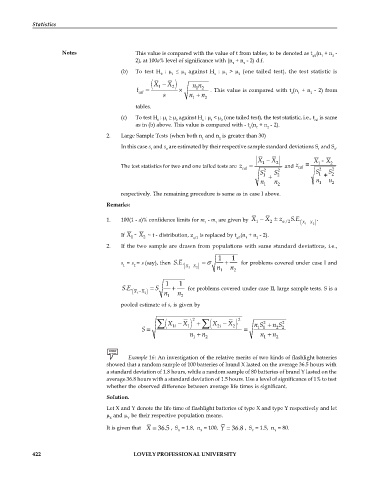Page 430 - DMTH404_STATISTICS
P. 430
Statistics
Notes This value is compared with the value of t from tables, to be denoted as t (n + n -
a/2 1 2
2), at 100a% level of significance with (n + n - 2) d.f.
1 2
(b) To test H : £ against H : > (one tailed test), the test statistic is
0 1 2 a 1 2
(X - X 2 ) n n
1
t cal = ´ 1 2 . This value is compared with t (n + n - 2) from
s n + n a 1 2
1 2
tables.
(c) To test H : ³ against H : < (one tailed test), the test statistic, i.e., t is same
0 1 2 a 1 2 cal
as in (b) above. This value is compared with - t (n + n - 2).
a 1 2
2. Large Sample Tests (when both n and n is greater than 30)
1 2
In this case s and s are estimated by their respective sample standard deviations S and S .
1 2 1 2
X - X 2 X - X 2
1
1
The test statistics for two and one tailed tests are z = and z cal =
cal 2 2 2 2
S S S 1 S 2
1 + 2 +
n n n 1 n 2
1 2
respectively. The remaining procedure is same as in case I above.
Remarks:
E
1. 100(1 - a)% confidence limits for m - m are given by X - X ± z /2 S . . .
2
1
1 1 (X 1 X- 2 )
If X - X ~ t - distribution, z is replaced by t (n + n - 2).
1
2
a/2
1
2
a/2
2. If the two sample are drawn from populations with same standard deviations, i.e.,
1 1
s = s = s (say), then . .S E = s + for problems covered under case I and
1 2 (X 1 X- 2 ) n n
1 2
1 1
S . . = S + for problems covered under case II, large sample tests. S is a
E
(X 1 X- 2 ) n n
1 2
pooled estimate of s, is given by
2 2
å (X - X 1 ) + å (X - X 2 ) n S + n S 2
2
2i
1i
S = = 1 1 2 2
n + n n + n
1 2 1 2
Example 16: An investigation of the relative merits of two kinds of flashlight batteries
showed that a random sample of 100 batteries of brand X lasted on the average 36.5 hours with
a standard deviation of 1.8 hours, while a random sample of 80 batteries of brand Y lasted on the
average 36.8 hours with a standard deviation of 1.5 hours. Use a level of significance of 1% to test
whether the observed difference between average life times is significant.
Solution.
Let X and Y denote the life time of flashlight batteries of type X and type Y respectively and let
and be their respective population means.
X Y
It is given that X = 36.5 , S = 1.8, n = 100, Y = 36.8 , S = 1.5, n = 80.
Y
X
X
Y
422 LOVELY PROFESSIONAL UNIVERSITY

